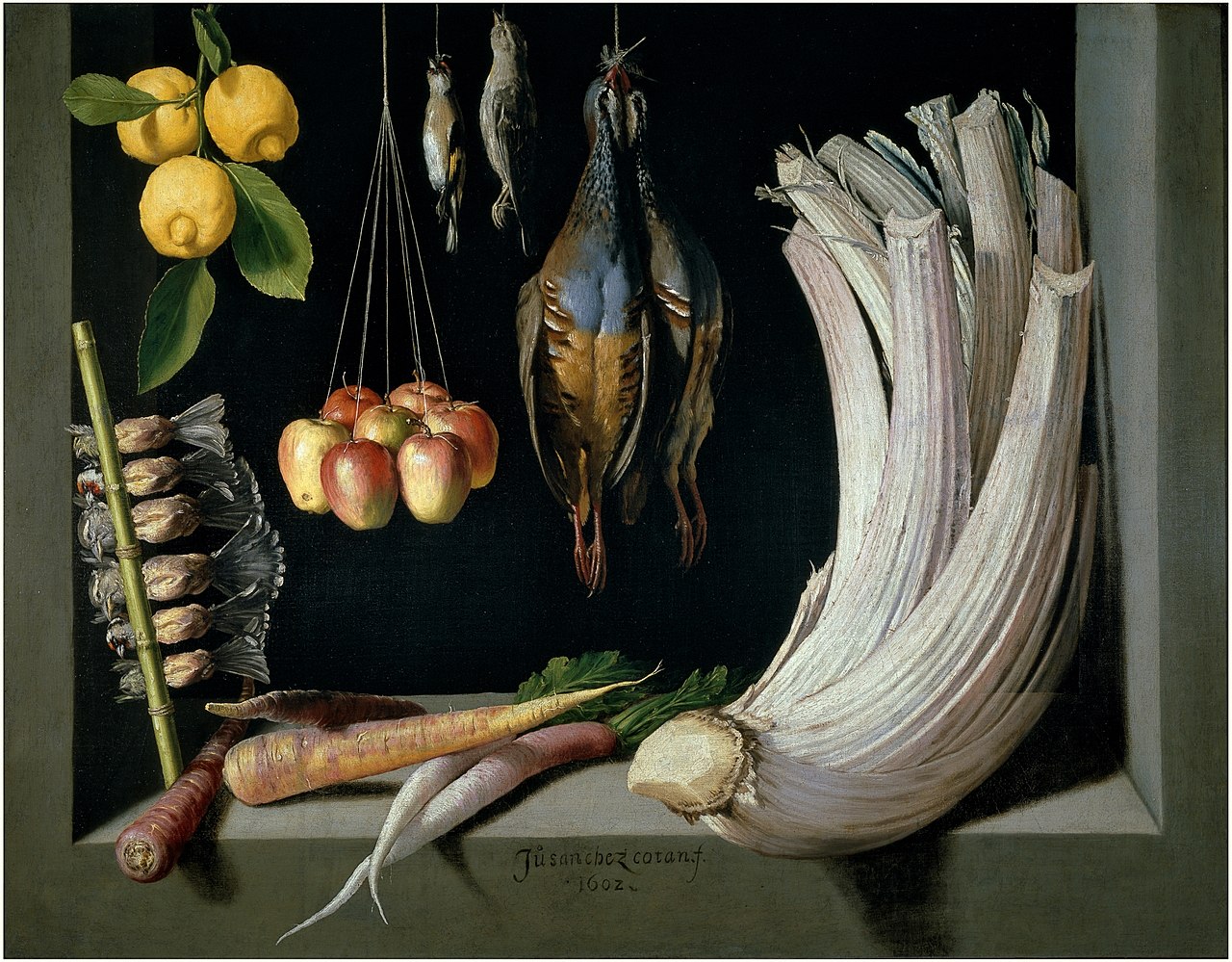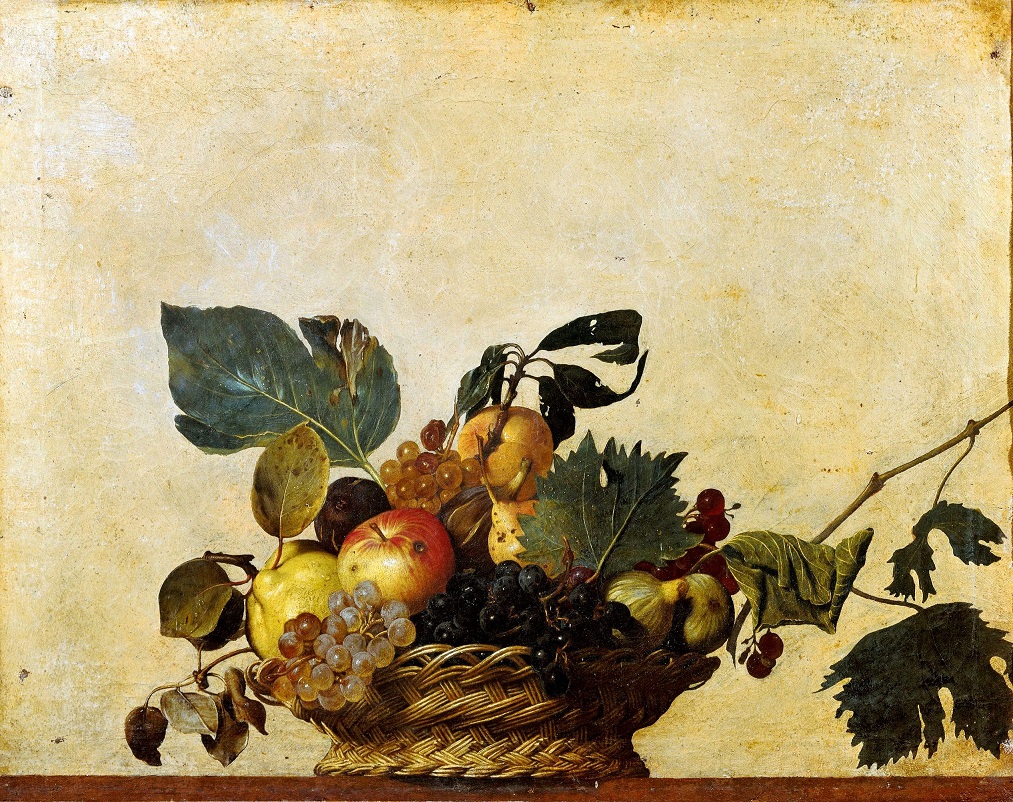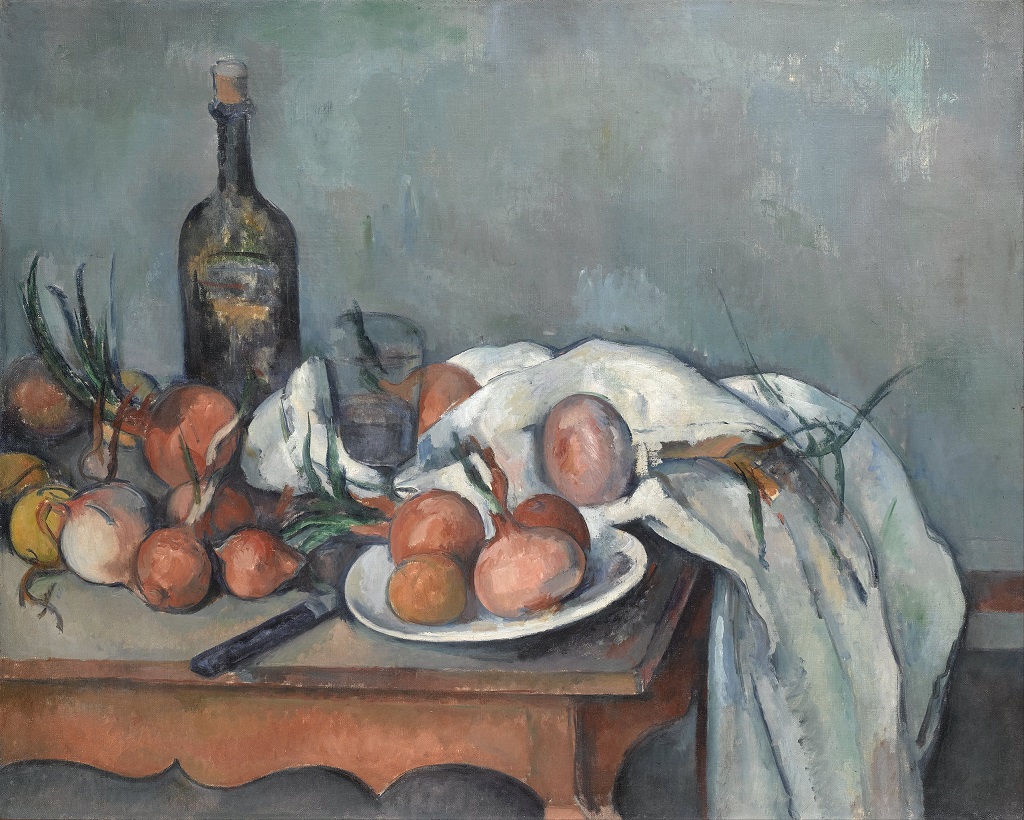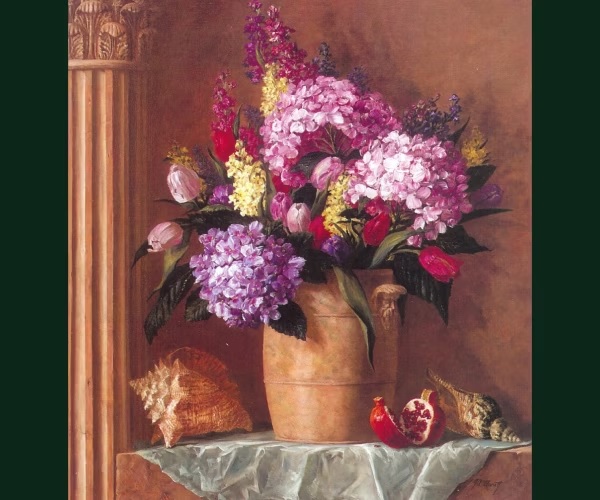
By Staff Middle Land
By Alexandra York
Subject matter in still life paintings typically consists of mostly inanimate objects, often of common household usage, and has existed in one form or another since ancient times.
Egyptians depicted foodstuffs on the walls within burial sites as offerings to the gods or to accompany the dead on their journey to the afterlife, and the Greeks decorated vases, mosaics, and wall paintings with ornamental or symbolic objects as well. Later, during Roman times, the artistic practice was used in mosaics of still life subjects like glass bowls with fruit, proof of which has been unearthed in cities like Pompei and Herculaneum; these are conjectured to have been displayed in wealthy Roman’s homes as signs of opulence or hospitality.
During medieval and early renaissance periods, still life objects were often included in religious painting and frescoes as well as decorating illuminated manuscripts, but they had no “star power” so were used for background interest rather than as serious objects of primary interest. (Sidebar: It is noteworthy, however, that — no surprise! — the great humanist Leonardo da Vinci broke from the religious tradition and painted a watercolor study of fruit in (it is estimated) 1495.

The art form finally came into its own as a unique genre in the 16th-century — Caravaggio is often cited as the first authentic still life painter with his now-famous “Basket of Fruit,” done in 1597.
And it is fully accepted in art history annals that the form actually came into its own, flourishing grandly in the Netherlands during the 17th-century when the emergence of the bourgeoisie (middle class) achieved lifestyles that included lavish possessions and the funds to celebrate the “fruits” of those lifestyles in art forms that gave them what today we would term “bragging rights” to glamorize their possessions in paintings to decorate their homes.
Hence, we see pictorial compositions from that period consisting of silver and gold goblets, epergnes, pitchers, etc., exquisite glass and porcelain ware, meat, fish and fowl, fruits and flowers, and all manner of expensive items for gracious living and prideful display.
The genre actually became so popular during this heyday period that artists would set up stalls and sell non-commisioned paintings to ordinary folks who did not own any real treasures but felt that owning a painting of such luscious objects carried prestige all by itself.
Symbolism communicated by objects was in play during virtually every period that still life paintings were executed. Fruit and flowers, in particular, were full of connotations that worked to remind living people that they, too, may ripen and blossom to lushness and beauty but will wither and die just like the objects in the painting. Lighter meanings also were well known and more pleasurable to contemplate such as the rose representing the Virgin Mary, the lily glorifying purity, and the sunflower bespeaking peace and grace.
These symbols were not always beautiful and inspiring (if a little unsettling) like the fruit and flowers. Some were horrific and others warmly familiar: Skeletons, skulls, and dead animals; books, pots, and wine bottles; and all sorts of seemingly odd objects were well understood metaphorically by the art-loving public of their own time.
But the compositional and painterly challenges of the still life art form from object arrangements to color tonalities and textures, to renderings of translucent glass and glinting metals intrigued countless painters long after the 17th-century rage and include such unexpected names as Van Gogh and Cezanne.

Today, contemporary painters still find challenges in the art form, all artists now with modern sensibilities but different with authentic creative talent or lack thereof. Some commercial” artists just paint simplistic “pretty pictures” depicting object arrangements as mere colorful abstract shapes that carry no further meaning.
Others of great artistic merit and personal intellect create seriously contemplative works that by thoughtful selection and provocative combination of objects imbue their work with inner contextual meaning that stimulates a thoughtful viewer’s curiosity and inspires investigation into the deeper meanings lying within the objects: “Why is that pomegranate (symbol — from Greek mythology — of Persephone’s eating the fruit’s seeds, an act that forced her to live with Hades in the underworld for half the year) placed right there next to a seashell?” (See above still-life painting “Eterne” by American contemporary artist Joe Anna Arnett. Photograph by Barrett Randell.)

In summary, we can endlessly explore this long enduring and eternally fascinating — and often underrated — art form that retains its beauty and mystery from an ancient inception to a future tomorrow.
Every epoch of this art form’s existence bespeaks the aura of each era’s underlying premises and preoccupations; thus, living inside every still-life is the real-life heartbeat and mindset of the painters and the viewing inhabitants of every historical period, projecting and preserving their own particular contemporary and unique experiences, concerns, and pleasures.
Original article: Newsmax








Cancel anytime


Using our website
You may use the The Middle Land website subject to the Terms and Conditions set out on this page. Visit this page regularly to check the latest Terms and Conditions. Access and use of this site constitutes your acceptance of the Terms and Conditions in-force at the time of use.
Intellectual property
Names, images and logos displayed on this site that identify The Middle Land are the intellectual property of New San Cai Inc. Copying any of this material is not permitted without prior written approval from the owner of the relevant intellectual property rights.
Requests for such approval should be directed to the competition committee.
Please provide details of your intended use of the relevant material and include your contact details including name, address, telephone number, fax number and email.
Linking policy
You do not have to ask permission to link directly to pages hosted on this website. However, we do not permit our pages to be loaded directly into frames on your website. Our pages must load into the user’s entire window.
The Middle Land is not responsible for the contents or reliability of any site to which it is hyperlinked and does not necessarily endorse the views expressed within them. Linking to or from this site should not be taken as endorsement of any kind. We cannot guarantee that these links will work all the time and have no control over the availability of the linked pages.
Submissions
All information, data, text, graphics or any other materials whatsoever uploaded or transmitted by you is your sole responsibility. This means that you are entirely responsible for all content you upload, post, email or otherwise transmit to the The Middle Land website.
Virus protection
We make every effort to check and test material at all stages of production. It is always recommended to run an anti-virus program on all material downloaded from the Internet. We cannot accept any responsibility for any loss, disruption or damage to your data or computer system, which may occur while using material derived from this website.
Disclaimer
The website is provided ‘as is’, without any representation or endorsement made, and without warranty of any kind whether express or implied.
Your use of any information or materials on this website is entirely at your own risk, for which we shall not be liable. It is your responsibility to ensure any products, services or information available through this website meet your specific requirements.
We do not warrant the operation of this site will be uninterrupted or error free, that defects will be corrected, or that this site or the server that makes it available are free of viruses or represent the full functionality, accuracy and reliability of the materials. In no event will we be liable for any loss or damage including, without limitation, loss of profits, indirect or consequential loss or damage, or any loss or damages whatsoever arising from the use, or loss of data, arising out of – or in connection with – the use of this website.
Last Updated: September 11, 2024
New San Cai Inc. (hereinafter “The Middle Land,” “we,” “us,” or “our”) owns and operates www.themiddleland.com, its affiliated websites and applications (our “Sites”), and provides related products, services, newsletters, and other offerings (together with the Sites, our “Services”) to art lovers and visitors around the world.
This Privacy Policy (the “Policy”) is intended to provide you with information on how we collect, use, and share your personal data. We process personal data from visitors of our Sites, users of our Services, readers or bloggers (collectively, “you” or “your”). Personal data is any information about you. This Policy also describes your choices regarding use, access, and correction of your personal information.
If after reading this Policy you have additional questions or would like further information, please email at middleland@protonmail.com.
PERSONAL DATA WE COLLECT AND HOW WE USE IT
We collect and process personal data only for lawful reasons, such as our legitimate business interests, your consent, or to fulfill our legal or contractual obligations.
Information You Provide to Us
Most of the information Join Talents collects is provided by you voluntarily while using our Services. We do not request highly sensitive data, such as health or medical information, racial or ethnic origin, political opinions, religious or philosophical beliefs, trade union membership, etc. and we ask that you refrain from sending us any such information.
Here are the types of personal data that you voluntarily provide to us:
As a registered users or customers, you may ask us to review or retrieve emails sent to your business. We will access these emails to provide these services for you.
We use the personal data you provide to us for the following business purposes:
Information Obtained from Third-Party Sources
We collect and publish biographical and other information about users, which we use to promote the articles and our bloggers who use our sites. If you provide personal information about others, or if others give us your information, we will only use that information for the specific reason for which it was provided.
Information We Collect by Automated Means
Log Files
The site uses your IP address to help diagnose server problems, and to administer our website. We use your IP addresses to analyze trends and gather broad demographic information for aggregate use.
Every time you access our Site, some data is temporarily stored and processed in a log file, such as your IP addresses, the browser types, the operating systems, the recalled page, or the date and time of the recall. This data is only evaluated for statistical purposes, such as to help us diagnose problems with our servers, to administer our sites, or to improve our Services.
Do Not Track
Your browser or device may include “Do Not Track” functionality. Our information collection and disclosure practices, and the choices that we provide to customers, will continue to operate as described in this Privacy Policy, whether or not a “Do Not Track” signal is received.
HOW WE SHARE YOUR INFORMATION
We may share your personal data with third parties only in the ways that are described in this Privacy Policy. We do not sell, rent, or lease your personal data to third parties, and We does not transfer your personal data to third parties for their direct marketing purposes.
We may share your personal data with third parties as follows:
There may be other instances where we share your personal data with third parties based on your consent.
HOW WE STORE AND SECURE YOUR INFORMATION
We retain your information for as long as your account is active or as needed to provide you Services. If you wish to cancel your account, please contact us middleland@protonmail.com. We will retain and use your personal data as necessary to comply with legal obligations, resolve disputes, and enforce our agreements.
All you and our data are stored in the server in the United States, we do not sales or transfer your personal data to the third party. All information you provide is stored on a secure server, and we generally accepted industry standards to protect the personal data we process both during transmission and once received.
YOUR RIGHTS/OPT OUT
You may correct, update, amend, delete/remove, or deactivate your account and personal data by making the change on your Blog on www.themiddleland.com or by emailing middleland@protonmail.com. We will respond to your request within a reasonable timeframe.
You may choose to stop receiving Join Talents newsletters or marketing emails at any time by following the unsubscribe instructions included in those communications, or you can email us at middleland@protonmail.com
LINKS TO OTHER WEBSITES
The Middle Land include links to other websites whose privacy practices may differ from that of ours. If you submit personal data to any of those sites, your information is governed by their privacy statements. We encourage you to carefully read the Privacy Policy of any website you visit.
NOTE TO PARENTS OR GUARDIANS
Our Services are not intended for use by children, and we do not knowingly or intentionally solicit data from or market to children under the age of 18. We reserve the right to delete the child’s information and the child’s registration on the Sites.
PRIVACY POLICY CHANGES
We may update this Privacy Policy to reflect changes to our personal data processing practices. If any material changes are made, we will notify you on the Sites prior to the change becoming effective. You are encouraged to periodically review this Policy.
HOW TO CONTACT US
If you have any questions about our Privacy Policy, please email middleland@protonmail.com
The Michelin brothers created the guide, which included information like maps, car mechanics listings, hotels and petrol stations across France to spur demand.
The guide began to award stars to fine dining restaurants in 1926.
At first, they offered just one star, the concept was expanded in 1931 to include one, two and three stars. One star establishments represent a “very good restaurant in its category”. Two honour “excellent cooking, worth a detour” and three reward “exceptional cuisine, worth a
Thank you for your participation,
please Log in or Sign up to Vote

123Sign in to your account